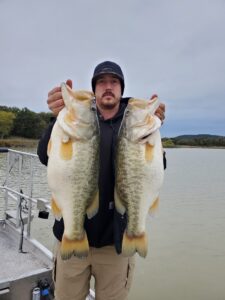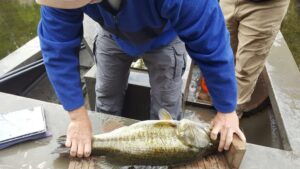“I just want to see what is in there.”
That is the most common answer we get when asking a new client why they want to electrofish their lake. If you truly don’t know what is swimming in your lake or if you are not catching any fish at all; then a fish survey can certainly answer that. In fact, the best tool for taking a snapshot of the fish assemblage at a given point in time is to electrofish. Fish surveys are best utilized for monitoring changes within the population. The results are used to make management corrections to ensure that your gamefish meet or exceed their expected growth rates year in and year out.

Trophy Bass
Gamefish and forage populations are highly dynamic and can change rapidly based on spawning success, survival, natural mortality, angling pressure, and environmental conditions. Therefore it is critical that electrofishing surveys be performed a minimum of every 2 years when quality fish production is the primary goal.
Different Reasons to Electrofish
Let’s say you experience drought and extreme heat like the north Texas heatwaves of 2011 or 2022. These conditions lower lake levels and concentrate fish into a smaller area. This results in the loss of spawning habitat and shoreline protection for forage species. This makes them easy targets for hungry bass. As a result, you may enter the following year with a lack of forage to promote bass growth. An autumn electrofishing survey can detect this and allow prompt correction through supplemental stocking.
Or maybe optimum conditions allow a competing predator such as crappie to undergo a spring spawning boom that results in thousands of additional mouths to feed. Electrofishing will assess not only the species present, but also their relative densities. In most cases, the correct numbers and sizes of predators can be selectively removed or “culled” during the electrofishing process. Culling helps to establish the predator/prey balance for the following growing season.
We Also Measure the Health of Your Fish
These are just a few of the possible changes that can occur within a fish population in a single year. In addition to species diversity and density estimates, electrofishing surveys allow the collection of data such as body condition (Relative Weight), as well as age and growth information. This data is recorded every autumn and used in comparisons to show progress or decline in the quality of bass populations over time. This information is our primary consideration when making management recommendations for the coming year. These recommendations may include: assigning harvest length limits, culling quotas, corrective stocking, supplemental feeding programs, and habitat improvements. A qualified fisheries biologist can tailor these recommendations to meet your goals; which may include trophy bass, high catch rates of quality sized fish, or maximum sustained yield of panfish such as bluegill, redear sunfish, or crappie.

Recording Length & Weight Data
When it comes time to schedule an electrofishing survey, it is important to ask yourself what the primary objectives and goals are for your fishery. Keep in mind that small bodies of water will rarely, if ever, maintain proper predator/prey balance without direction and regular oversight from a certified fisheries biologist. Therefore, a one-time survey may not offer much in the way of immediate improvements.
Check out our Lake Management page for more information or call Magnolia Fisheries today to get started on a long-term fisheries management plan.
